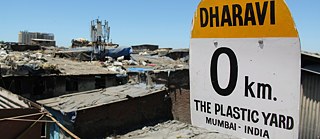Hip hop in the Slum
From Street Style to your own Label

Hip hop and breakdance only have a niche presence in the land of Bollywood. However, Sunil Rayana has done a great job of making the subculture popular in his neighborhood. He has even bigger plans for his company, Slumgods, in Mumbai.
By Martin Jahrfeld
While entrepreneurs elsewhere in the world have to worry about convincing banks and regulators about their business ideas, there are two other people you have to convince in India: mom and dad. In a society in which the majority of marriages are still arranged by the bride and groom’s families, most business ventures have to receive parents’ approval too. “At first they weren’t excited at all and would have rather have seen me working for an IT company,” reports Sunil Rayana, founder and co-owner of the Mumbai tour operator, Slumgods, but that was out of the question for the 28-year-old. An authoritarian work environment and extensive video surveillance of the office made getting out of being someone else’s employee unavoidable for Rayana. “It was one of the best steps of my life, even if it didn’t look that way in the beginning,” explains the entrepreneur, who is an accountant by trade.
The idea of venturing into organizing sightseeing tours, together with two friends, as a way of becoming independent in a city like Mumbai isn’t in itself a groundbreaking idea. There are numerous operators in the Indian metropolis, offering tours for all kinds of tastes and budgets. Rayana’s roots in the working class neighborhood, Dharavi, considered the biggest slum in Asia with its around one million residents, would prove to be a competitive advantage. So-called “slum tours” are also offered by other operators, but Rayana and his partners know the neighborhood way better than the others do, since they’ve been teaching hip hop and breakdance courses to the kids and teenagers there for years. The three young, Indian guys have a passion for American street art. “We got the kids excited about it right away. Their parents were a little skeptical at first, because this subculture is hardly known in India. But their skepticism subsided long ago. Our hip hop and breakdance courses are a solid part of the neighborhood today,” Rayana reports.
But the group’s engagement has caused a rapidly growing dynamic and professionalization to the scene beyond just teaching dance. A milieu of breakdancers, beatboxers, choreographers, graffiti artists and DJs has been established over the last couple of years. Many of them have worked with international hip hop grates, artists from the USA and Japan among them. Some Indian artists work on the side as tour guides for Slumgods to make some extra money and to make international contacts. Pawan is one of them, a 23-year-old from Dharawi, who’s working on his own hip hop career online under the name, 022-Maze. His videos and rapping style seem professional, but right now Pawan is looking for more stability and security in his like than instant success. “I have had really bad times and was just hanging around for a long time. It was really bad. That’s all changed through my work with Slumgods and the energy I get from hip hop,” reports the young artist.
The name of the company, Slumgods, is a nod to the incredibly successful film, Slumdog Millionaire, which also was set in Dharavi. The film wasn’t especially popular among the neighborhood’s residents, since the film presents the slum as a setting of poverty and violence, while many people see the district more as a prospering location full of economic chances. However, for Sunil Rayana and his colleagues, it was a windfall. The similarity in the names made A. R. Rahm, a well-known producer and composer who worked on the soundtrack, notice the trio and he offered to collaborate on music with them. “The fact that we were suddenly interesting for those kinds of famous people, gave us a push. And it also showed us that we were totally well positioned with the name Slumgods,” says Rayana.
Contact with international visitors through a sightseeing business would also prove to be vital going forward. “Guests from all over the world not only motivated us to continue on our path, they also helped us with concrete suggestions,” says the founder. This is especially true of the support they got from a tourist, who works as a manager in a PR agency in Germany. “I learned a lot from her about marketing and how to run a company, but also confidence and perseverance,” reports Rayana, whose ambitions today are remarkably greater than four years ago. In the future, he doesn’t just want to run tours for tourists, but also to market products made in Dharavi under the brand “Dharavi Bazar.” It’s a mammoth undertaking that he wants to give himself a few years to do. If he’s successful, it would be a true masterpiece. The workers and artisans of Dharavi produce large amounts of textiles, ceramics and leather goods for wholesalers and middlemen, but they don’t have any access to marketing or distribution. A location-specific umbrella brand would significantly improve the situations of the mostly impoverished producers. But even if the path to such goals is long off, there’s one goal that he’s definitely reached already: Mom and Dad are more than satisfied with their son.